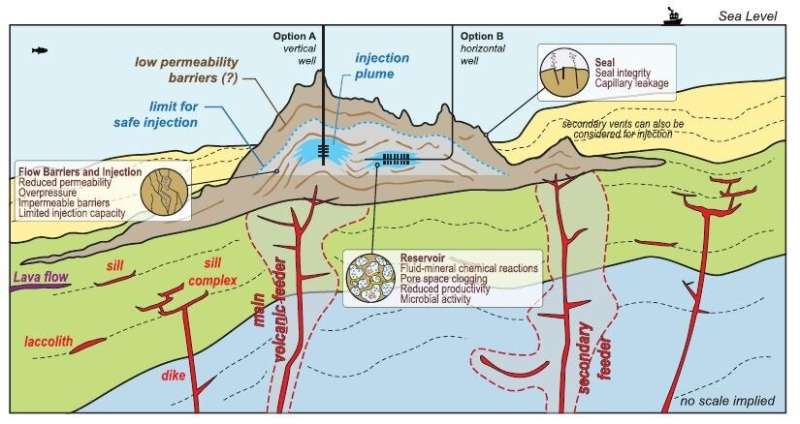This article has been reviewed according to Science X's editorial process and policies. Editors have highlighted the following attributes while ensuring the content's credibility:
fact-checked
peer-reviewed publication
trusted source
proofread
Extinct offshore volcano could store gigatons of carbon dioxide

A new study published in Geology concludes that an extinct volcano off the shore of Portugal could store as much as 1.2–8.6 gigatons of carbon dioxide, the equivalent of ~24–125 years of the country's industrial emissions.
For context, in 2022 a total of 42.6 megatons (0.0426 gigatons) of carbon dioxide was removed from the atmosphere by international carbon capture and storage efforts, according to the Global CCS Institute. The new study suggests that carbon capture and storage in offshore underwater volcanoes could be a promising new direction for removal and storage of much larger volumes of the greenhouse gas from the atmosphere.
"We know that most countries, including Portugal, are making efforts to decarbonize the economy and our human activities, this is a message that this may be one of the instruments to solve the problem" says Ricardo Pereira, a geologist at the NOVA School of Science and Technology, and co-author of the study.
Storing carbon dioxide in an extinct volcano would rely on a process known as "in situ mineral carbonation." In this process, carbon dioxide reacts with elements in certain types of rocks to produce new minerals that safely and permanently store the carbon dioxide. Elements like calcium, magnesium, and iron combine with carbon dioxide to form the minerals calcite, dolomite, and magnesite, respectively.
Rocks that contain large amounts of calcium, iron, and magnesium are ideal candidates for this process—such as the volcanic basalts that make up most of the sea floor. Knowing this, the researchers targeted an offshore volcano for a few reasons—the structure of the volcano could provide an ideal architecture for carbon injection and storage, the rocks are the right type for the reactions involved, and the location Is not too close to large populations, but also not too far.
Most carbon capture projects have relied on injection of carbon dioxide into porous sedimentary basins that are sealed to prevent migration of the gas out of reservoirs. In these cases, the carbon will eventually start to form minerals, but only over longer periods of time—decades to centuries. In 2016, researchers published findings that 95% of carbon dioxide injected into underground basalts in Iceland had mineralized within just two years. The much shorter mineralization time makes the process safer and more effective—once carbon is stored in minerals, issues like potential leaks are no longer a concern.
Davide Gamboa, a geologist at the University of Aveiro and co-author of the study, explains, "What makes mineral carbonation really interesting is the time. The faster it gets into a mineral, the safer it becomes, and once it's a mineral, it is permanent."

The researchers studied the storage potential at the ancient Fontanelas volcano, which is partially buried ~100 kilometers offshore from Lisbon, with a peak ~1500 meters below sea-level.
To estimate the potential volume of carbon dioxide that could be stored at this site, the authors used 2D and 3D seismic studies of the undersea volcano that had been produced during offshore oil exploration, as well as data from samples that had been dredged from the area in 2008. The dredged samples contained naturally formed carbonate minerals, indicating that the chemical reactions required to store carbon were already happening, and that intentional efforts to mineralize carbon in these rocks should be successful.
The samples also had up to 40% pore space—meaning there are spaces within the rocks where carbon dioxide could be injected and mineralized. The researchers also indicate that low-permeability layers imaged around the flanks of the volcano could help with containing the carbon dioxide before it is mineralized.
While this study demonstrated a large potential carbon storage capacity at the Fontanelas volcano, the authors highlight that many other places around the world may have similar offshore volcanoes that could be candidates for carbon capture and storage.
More information: Ricardo Pereira et al, In situ carbon storage potential in a buried volcano, Geology (2023). DOI: 10.1130/G50965.1
Journal information: Geology
Provided by Geological Society of America





















